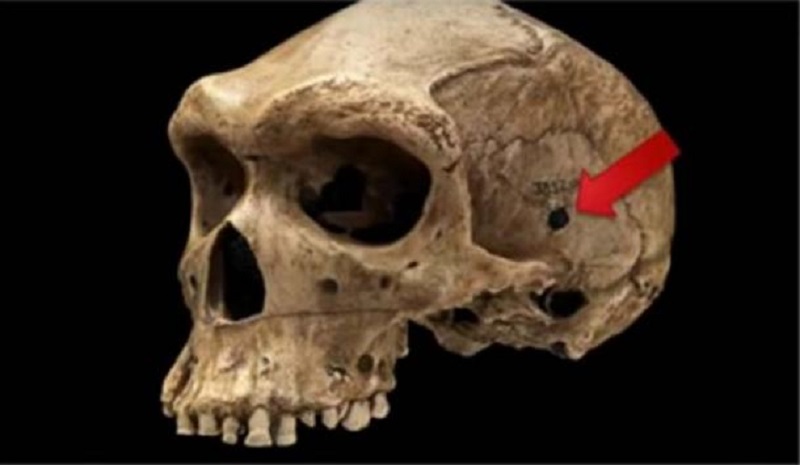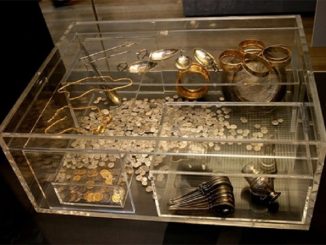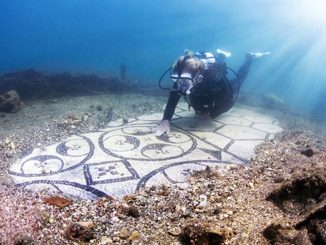Suspicious skull
On the ground floor of the Natural History Museum in London, a human skull is on display. It comes from a cave in Northern Rhodesia and has a perfectly round hole on the left side. There is no radical fracture that would normally appear if the wound was caused by a cold weapon. The right side of the skull was broken. The skulls of soldiers killed by rifle bullets have identical shapes. The skull was determined to be that of a man who lived more than 40,000 years ago at a time when guns were not yet invented. An arrow could not have created such a perfectly round hole in the left side of the skull and shattered the right side as well. Maybe there’s something wrong with the skull’s chronology, or the origin of the hole remains a mystery.
Side view of a prehistoric human skull discovered in 1921 at Broken Hill Cave, Northern Rhodesia (YouTube screenshot)
The Russian Museum of Paleontology has the skull of a bison believed to be hundreds of thousands of years old. It shows a clear round hole in the front part and scientific evidence has proven that although the skull was penetrated, the brain was not injured and the beast’s wounds healed. In that distant past, ape-men were said to be armed only with batons. The perfectly round hole with no radial line looks very much like a hole made by a bullet. The question is – who shot the bison?

Auroch’s skull has a bullet-like hole in its forehead. Photo source: Technology of the Gods: The Incredible Science of the Ancients
Mysterious meteorite
An unusually shaped meteorite found near Eaton, Colorado, has created a puzzle. Analysis by American meteorologist HH Nininger showed that the meteorite is composed of an alloy of copper, lead and zinc, that is, brass, which does not exist in nature. The meteorite cannot be “space junk” because it fell in 1931.

Harvey Harlow Nininger (1887 – 1986) was an American meteorologist and considered the father of modern meteorology (Fair Use).
Iron nails from ancient times?
In the 16th century, Spanish conquistadors found an 18 cm long iron nail firmly embedded in rock in a mine in Peru. The rock is estimated to be tens of thousands of years old. Since the American Indians had never heard of iron until the conquest, people wondered whose nail it was. Spanish Viceroy Don Francisco de Toledo kept the mysterious nail in his study as a souvenir.
According to the London Times on December 24, 1851, Mr. Hiram de Witt found a piece of yellow quartz in California. When he accidentally dropped it, an iron nail with a perfect head was found inside the quartz. At the same time, Sir David Brewster made a report to the British Association for the Advancement of Science, which created a stir. A block of stone from Kin-goodie quarry in northern England contains a nail, the end of which has been corroded. But at least an inch of it, including the head, is deep in the rock. Because the strata where these three iron nails were found are so old, the identity of their makers remains a mystery.
The steel block in the coal conundrum
In 1885 at the Isidor Braun foundry in Vöcklabruck, Austria, a block of coal broke and a small block of steel measuring 67 mm x 47 mm fell out. A deep cut runs all the way around and the edges are rounded on both sides. Only human hands can make these things.
Wolfsegg Iron Block or Salzburg Block (Public Domain)
Braun’s son brought this article to the Linz Museum but after decades it was lost. However, one cube was kept by the Linz Museum. Contemporary magazines such as Nature (London, November 1886) or L’Astronomie (Paris, 1887) all had articles about this strange discovery. Some scientists have tried to explain it as a meteorite from the Tertiary Coal Age. Others want an explanation for the groove around the cube, its perfect shape and its origin. Some people explain this as being similar to certain types of cast iron used in mining machinery as ballast. The debate never ends.
Conclusion from the unusual
These perplexities cannot be cleared up unless a reassessment of prehistory is made. The evidence collected here points to the existence of a technology at what we imagine was the dawn of humanity. Two theories could explain the artifacts described in this series of articles – either there was some kind of technological civilization in the bygone past, or the earth was visited by creatures from other generations. another world or dimension.
The significance of the mushroom stones in Guatemala was not discovered until linked to records of Mexican priests in Spain ( Public Domain )
We may not understand the true meaning of many artifacts in the museum. These marble, stone, wood or bronze ciphers could carry an important message. In 1946, the Carnegie Institution reported an archaeological find in Kaminajuyu, Guatemala – a strange 32 cm tall mushroom-shaped statue of a human face, with wide-open eyes at the base. The meaning of this object is still unclear, but when studying Spanish records about sacred mushrooms and their use by Mexican priests, experimenters decided to try these mushrooms. A hypnotic trance with hallucinatory images is created. The statue brings out the whole story symbolically.
These examples may not be definitive proof of advanced prior knowledge but these and other examples given previously certainly show us that possibility.





